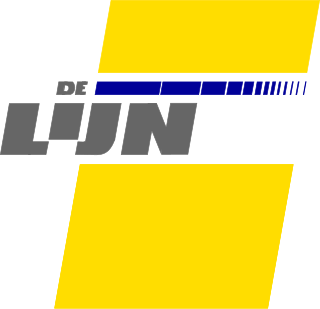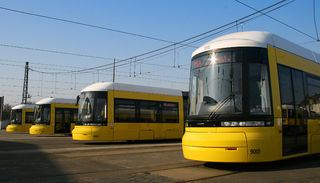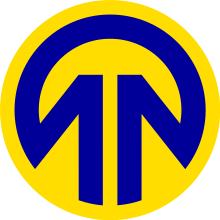
Vlaamse Vervoersmaatschappij De Lijn, usually known as De Lijn, is a company run by the Flemish government in Belgium to provide public transportation with about 2240 buses and 399 trams. De Lijn was founded in 1991 after the public transportation companies of Antwerp and Ghent fused with the Flemish part of the NMVB.

The Berlin tramway is the main tram system in Berlin, Germany. It is one of the oldest tram networks in the world having its origins in 1865 and is operated by Berliner Verkehrsbetriebe (BVG), which was founded in 1929. It is notable for being the third-largest tram system in the world, after Melbourne and St. Petersburg. Berlin's tram system is made up of 22 lines that operate across a standard gauge network, with almost 800 stops and measuring almost 190 kilometres (120 mi) in route length and 430 kilometres (270 mi) in line length. Nine of the lines, called Metrotram, operate 24 hours a day and are identified with the letter "M" before their number; the other thirteen lines are regular city tram lines and are identified by just a line number.

A horsecar, horse-drawn tram, horse-drawn streetcar (U.S.), or horse-drawn railway (historical), is an animal-powered tram or streetcar.
The Tramways vicinaux or Buurtspoorwegen were a system of narrow-gauge tramways or local railways in Belgium, which covered the whole country and had a greater route length than the mainline railway system. They were 1,000 mmmetre gauge and included electrified city lines and rural lines using steam locomotives and diesel railcars; half the system was electrified.
Trams in India were established in the late-19th century. Horse-drawn trams were introduced in Kolkata in 1873; electric trams began in Chennai in 1895, and trams were also introduced in Mumbai, Kanpur, and Delhi. They were discontinued in all Indian cities between 1933 and 1964, except for Kolkata.

The tram system in Brussels, Belgium is the 16th largest tram system in the world by route length, in 2017 providing 149.1 million journeys over routes 140.6 km in length. In 2018, the Brussels tram system consisted of 18 tram lines. Its development has demonstrated many of the quandaries that face local public transport planners. The Brussels tram system also has several interesting peculiarities: the inconsistent route pattern resulting from the closure of the interurban trams, the conflict between low-floor surface trams and high-floor underground trams, and whether the trams run on the right or the left.

The Coast Tram is a public transport service connecting the cities and towns along the entire Belgian coast, between De Panne near the French border and Knokke-Heist near the Dutch border. At 67 kilometres (42 mi) in length, it is the world's longest tram/light rail line in service, as well as one of the few interurban tramways in the world to remain in operation. The line is built at 1,000 mmmetre gauge and fully electrified at 600 V DC. In 2022, the A Line in Los Angeles, California will supersede the Coast Tram at 79.7 kilometres (49.5 mi) as the longest light rail/tram line in the world once connected and merged with the L Line.

Trams in New Zealand were a major form of transport from the 19th century into the mid-20th century. New Zealand's first (horse) tramway was established in 1862 (Nelson), followed by a steam tramway in 1871 (Thames), and the first electric tramway in 1900. In New Zealand railway terminology a bush tramway is an industrial tramway, which usually did not carry passengers.

The Antwerp premetro tram route 3 is a tram route connecting Merksem with Melsele in the city of Antwerp. The route is operated by the Flemish transport company De Lijn and historically also by its Antwerp predecessor, MIVA.

The Frankfurt am Main tramway network is a network of tramways forming a major part of the public transport system in Frankfurt am Main, a city in the federal state of Hesse, Germany.

The Ghent tramway network is a network of tramways forming part of the public transport system in Ghent, a city in the Flemish Region of Belgium, with a total of three lines. Since 1991, the network has been operated by De Lijn, the public transport entity responsible for buses and trams in Flanders.

Between 1901 and 1949 Manchester Corporation Tramways was the municipal operator of electric tram services in Manchester, England. At its peak in 1928, the organisation carried 328 million passengers on 953 trams, via 46 routes, along 292 miles (470 km) of track.

Wolverhampton Corporation Tramways operated a tramway service in Wolverhampton between 1902 and 1928.

Gloucester Corporation Tramways operated an electric tramway service in Gloucester between 1904 and 1933.

The Bonn tramway network forms part of the public transport system in the city Bonn, North Rhine-Westphalia, Germany, along with the Bonn Stadtbahn with which the tramlines are heavily integrated. The tram network consists of three tram lines which makes Bonn's tramway relatively small, as it comprises only 29.52 kilometres (18.34 mi) of route. The tramway is operated by 24 low-floor tramcars.

Tram route 6 is a tram route in Antwerp between the Metropolis P+R in the northern Luchtbal suburb and the Olympiade P+R in the southern Kiel neighborhood, using the pre-metro network between stations Sport and Plantin. The route was officially opened on 27 October 2007 and is operated by the Flemish transport company De Lijn.

Tram route 9 is a route in the Antwerp tram network connecting the Eksterlaar neighborhood in southern Deurne with Linkeroever using the Antwerp premetro network between Plantin and Van Eeden stations. The present day route was officially opened on September 1, 2012, as part of a revision of the network map.

Tram route 11 is an above ground tram route in the city of Antwerp, Belgium. It currently runs between the Antwerpen-Berchem railway station and the Melkmarkt in the city centre.
Bradford Corporation Tramways were a tramway network in the city of Bradford, West Riding of Yorkshire, England which operated trams from 1882 until 1950 and trolleybuses from 1911 until 1972. The track gauge of the tramways was 4 ft.
Tram Route 10 is a tram route in Antwerp and nearby Wijnegem. Tram route 10 entered operation in 1873, making it one of the oldest tram routes still active in Antwerp, next to Tram Route 4 (Antwerp) and Tram Route 7 (Antwerp).


















